The London, Midland and Scottish Railway (LMS) Stanier Class 5 4-6-0, commonly known as the Black Five, is a class of 4-6-0 steam locomotives. It was introduced by William Stanier and built between 1934 and 1951. A total of 842 were built initially numbered 4658-5499 then renumbered 44658-45499 by BR. Several members of the class survived to the last day of steam on British Railways in 1968, and eighteen are preserved.
| LMS Stanier Class 5 4-6-0 | |||||||||||||||||||||||||||||||||||||||||||||||||||
|---|---|---|---|---|---|---|---|---|---|---|---|---|---|---|---|---|---|---|---|---|---|---|---|---|---|---|---|---|---|---|---|---|---|---|---|---|---|---|---|---|---|---|---|---|---|---|---|---|---|---|---|
 No. 44949 at Manchester Victoria in 1968. | |||||||||||||||||||||||||||||||||||||||||||||||||||
| |||||||||||||||||||||||||||||||||||||||||||||||||||
| |||||||||||||||||||||||||||||||||||||||||||||||||||
| |||||||||||||||||||||||||||||||||||||||||||||||||||
| |||||||||||||||||||||||||||||||||||||||||||||||||||
Origins
The Black Five was a mixed-traffic locomotive, a "do-anything go-anywhere" type, designed by Stanier, who had previously been with the GWR. In his early LMS days, he designed his Stanier Mogul 2-6-0, experimenting with the GWR school of thought on locomotive design. A number of details in this design he would never use again, realising the superiority of details not used on the GWR. Stanier realised that there was a need for larger locomotives. These were to be the LMS version of the GWR Halls, but they were not copies, as the Hall was too wide to run in most places in Britain. They shared a similar cylinder arrangement (two outside), internal boiler design and size and 6 foot driving wheel diameters.[1]
In their early days the locomotives were known as the "Black Staniers" from their black livery, in contrast to Stanier's other class of 4-6-0, the LMS Jubilee Class, which were painted crimson (and known until April 1935 as the "Red Staniers").[2][3] Later on, the nickname of the former became "Black Five", the number referring to the power classification. This was originally 5P5F, but from 1940 was shown on cabsides as the simple figure 5. Eight hundred and forty-two were constructed.[4] The locomotives were an instant success and were well-liked by their crews for their versatility.[5][6] One of them was recorded to have reached a speed of 96 mph in service.[7][8][9]
Construction
There were a number of detail variations in the locomotives and they did not all remain in the same condition as built. Some locomotives built under British Railways administration were used as test beds for various design modifications, with a view to incorporating the successful modifications in the Standard Classes of locomotives built from 1951 onwards. These modifications included outside Caprotti valve gear, roller bearings (both Timken and Skefco types) on the coupled and tender axles in varying combinations, and an experimental steel firebox. Other locomotives had modified draughting to "self clean" the smokebox (thereby reducing turn-around and disposal times and eliminating or mitigating one of the most unpopular jobs).[10]
The domeless engines

Numbering started from 5000, with the first twenty being ordered from Crewe Works in April 1934, and a further fifty (5020–5069) ordered from the Vulcan Foundry in 1933.[11] The first of the Vulcan Foundry engines entered service in 1934, and the entire order of 50 was delivered before the first Crewe-built engine, No. 5000, was completed in February 1935.[12] The first 57 locomotives were built with domeless boilers with straight throatplates and a low degree of superheat (14 elements in two rows), the boilers of the remaining 13 (5007–5019) were provided with a three-row version (21 elements)[13] having greater total surface area and giving less obstruction to gas flow.[12] The original 57 boilers were converted later to higher superheat (24 elements) and fitted with a dome. Further orders were placed with Crewe (5070–5074), Vulcan Foundry (5075–5124) and Armstrong Whitworth (5125–5224) for a total of 155 locomotives which were also built with domeless boilers with straight throatplates and 21 element superheaters. All these boilers, including the early converted ones with a dome, were fitted indiscriminately to any of the first 225 engines, which could appear at various times with domed or domeless boilers.
However, many of the early frames were converted to accept sloping throatplate boilers, as listed below. This modification was carried out to provide a stock of spare boilers for the early engines, which would minimise the time spent in works by engines awaiting a fresh boiler. All locomotives from no. 5225 were fitted when new with the sloping throatplate boiler. All extra boilers made had the sloping throatplate arrangement, and only one example of a later engine having been fitted with a straight throatplate boiler is known - no. 45433. Several different patterns of boiler were used on the locomotives, running into double figures. The throatplate design was the most significant, but there were also different numbers of superheater flues, firegrate arrangement, stay material, dome and water feed arrangements, washout plug placement, etc. in various combinations.
The following locomotives were built with straight throatplate boilers, but were later fitted with a sloping throatplate boiler (date in brackets). Conversion was done by relocating the frame stretcher immediately in front of the firebox. Some of them reverted to straight throatplate at a later date, and these are also shown where known. Those marked with an asterisk were fitted with a boiler which had the top feed on the front ring on the date shown. In the case of no. 45087 it had previously been converted. The first conversion was carried out on no. 5022, and the last known was on no. 45163, which has been preserved.
5002 (12/37), 45007 (1/60), 45008 (1/60*), 45011 (1/49*+), 5020 (2/37), 5022 (10/36) reverted (10/58), 5023 (2/38) reverted (3/53), 5026 (2/37) reverted (1/59), 5027 (12/36), 5040 (11/36), 5045 (11/54), 5047 (1/37), 45049 (7/54) reverted (8/59), 5054 (1/37), 5057 (11/37), 5058 (11/37), 5059 (7/45), 45066 (4/60), 45082 (12/56*), 45087 (9/55) (12/60*), 5097 (1/37), 5108 (6/45), 45109 (5/48), 5142 (12/37), 45151 (3/51), 45163 (5/61), 45169 (7/55), 45197 (5/60)
The pre-war domed engines
A further 227 were ordered from Armstrong-Whitworth in 1936, the largest single locomotive order ever given by a British railway to an outside contractor. Crewe built a further 20, which had higher degree superheat boilers, with 28 elements, unlike the AW boilers, which had 24 elements.
5471, built at Crewe in 1938, would be the last built for five years. During the early stages of the Second World War, the priority was for heavy freight engines, and the closely related 8Fs were produced in large numbers.
Wartime and postwar domed engines
In 1943 construction was restarted, with Derby Works building its first. Construction continued up to no. 5499. As the numbering block from 5500 was allocated to the Patriot Class, a further batch of 200 locomotives were numbered from 4800 to 4999, followed by a batch from 4658 to 4799. By this time the LMS had been nationalised, and British Railways added 40000 to all numbers. Eventually the 842 examples would number 44658–45499.
Ivatt engines and experimental modifications
From early 1947, engines were built with the top feed on the front ring of the boiler (from no. 4998), and Nos 44758-767 had a longer wheelbase (27 ft 6in rather than 27 ft 2in, with the change in the coupled wheelbase from 7 ft + 8 ft to 7 ft + 8 ft 3in); this was necessary in order to accommodate the Timken roller-bearing housings without fouling the ashpan.[14] In 1948, George Ivatt introduced more modifications to bearings and valve gear; other experimental Ivatt features included the use of steel rather than copper fireboxes on certain engines, and the fitting of double blastpipes & chimneys in some instances. 44738-57 were built with Caprotti valve gear. The last two, nos. 44686 and 44687 built at Horwich in 1951, were fitted with a new arrangement of Caprotti valve gear, which was later used on some of the BR standard Class fives, and the BR class 8 4-6-2.
No. 4767, built at Crewe and delivered in December 1947, had outside Stephenson valve gear: instead of eccentrics, double return cranks were used to drive the eccentric rods, and a launch-type expansion link was used. This one cost £13,278, which was about £600 more than those built at the same time with Walschaerts' valve gear. The aim of the experiment was to find out if a valve gear having variable lead (as opposed to the constant lead of the Walschaerts' motion) would affect performance. On trial, it proved to have no advantage, although in normal service it did gain a reputation as a good performer on banks.[15][16][17][18][19]
Accidents and incidents
- On 13 October 1939, No. 5025 was hauling an express passenger train from Euston to Stranraer (pilot to locomotive 6130 The West Yorkshire Regiment, an LMS Royal Scot Class 4-6-0) when it was in collision with locomotive LNWR Class G1 0-8-0 9169, which was attaching a van to the rear of an Inverness train at Bletchley, Buckinghamshire, severely damaging it. Five people were killed and more than 30 were injured.[20] No. 5025 was repaired and survives at the Strathspey Railway.
- In 1941, locomotive No. 5425 was severely damaged in a Luftwaffe air raid. It was subsequently repaired at Crewe Works.[21]
- On 1 January 1946, engine No. 5495 was involved in the Lichfield rail crash, in which the freight train it was hauling was derailed at Lichfield Trent Valley station, Staffordshire due to faulty points. The train collided with a passenger train, which was hauled by LNWR Prince of Wales Class 4-6-0 no. 25802, killing 20 people and injuring 21.[22]
- On 23 January 1955, locomotive No. 45274 was hauling an express passenger train that was derailed due to excessive speed on a curve, in the Sutton Coldfield rail crash. Nineteen people were killed and 64 were injured.[23]
- On 16 January 1958, a locomotive of the class was hauling a passenger train that collided with a light engine that was standing foul of the line at Preston due to a signalman's error. Both trains were derailed; thirteen people were injured.[24]
- On 4 February 2006, locomotive 45305 Alderman A. E. Draper collided with a rake of six carriages at Loughborough Central, damaging the locomotive and one of the carriages. Two people were injured. An investigation by the Rail Accident Investigation Branch (RAIB) found that the driver was not wearing spectacles at the time of the accident, despite it being a requirement on his medical certificate to do so when driving.[25]
- On 2 October 2015, locomotive No. 45231 was working a private charter train for West Coast Railways (WCRC) through Doncaster when it was noticed that its TPWS (Train Protection and Warning System) had been isolated by the footplate crew. Isolation of the TPWS had been a factor in the Wootton Bassett SPAD incident in March of the same year. As a result, WCRC were suspended from operating on the national network by the Office of Rail and Road.[26]
Construction details
| LMS No. | BR No. | Lot No. | Date | Built at | Boiler type | Valve gear (Walschaerts unless stated) | Bearings (plain unless stated) | Additional notes |
|---|---|---|---|---|---|---|---|---|
| 44658–67 | 199 | 1949 | Crewe | Forward topfeed | Coupled wheelbase 7'+ 8'3" | |||
| - | 44668/9 | 199 | 1949 | Horwich | Forward topfeed | Skefco roller bearings on driving axles | Coupled wheelbase 7'+ 8'3" | |
| - | 44670–7 | 199 | 1950 | Horwich | Forward topfeed | Skefco roller bearings on driving axles | Coupled wheelbase 7'+ 8'3" | |
| - | 44678–85 | 199 | 1950 | Horwich | Forward topfeed | Skefco roller bearings throughout | Coupled wheelbase 7'+ 8'3" | |
| - | 44686/7 | 199 | 1951 | Horwich | Forward topfeed | British Caprotti | Skefco roller bearings throughout | Coupled wheelbase 7'+ 8'3" |
| - | 44688–97 | 199 | 1950 | Horwich | Forward topfeed | Timken roller bearings on driving axles | Coupled wheelbase 7'+ 8'3" | |
| - | 44698–717 | 192 | 1948 | Horwich | Forward topfeed | Coupled wheelbase 7'+ 8'3" | ||
| - | 44718–27 | 192 | 1948 | Crewe | Forward topfeed | Steel firebox, Coupled wheelbase 7'+ 8'3" | ||
| - | 44728–37 | 192 | 1948 | Crewe | Forward topfeed | Coupled wheelbase 7'+ 8'3" | ||
| - | 44738–47 | 187 | 1948 | Crewe | Forward topfeed | Caprotti | Timken roller bearings throughout | Coupled wheelbase 7'+ 8'3" |
| 4748–53 | 44748–53 | 187 | 1948 | Crewe | Forward topfeed | Caprotti | Timken roller bearings throughout | Coupled wheelbase 7'+ 8'3" |
| - | 44754–5 | 187 | 1948 | Crewe | Forward topfeed | Caprotti | Coupled wheelbase 7'+ 8'3" | |
| - | 44756–7 | 187 | 1948 | Crewe | Forward topfeed | Caprotti | double chimney, Coupled wheelbase 7'+ 8'3" | |
| 4758–66 | 44758–66 | 187 | 1947 | Crewe | Forward topfeed | Timken roller bearings throughout | Coupled wheelbase 7'+ 8'3" | |
| 4767 | 44767 | 187 | 1947 | Crewe | Forward topfeed | Stephenson link motion | Timken roller bearings throughout | double chimney, preserved - Coupled wheelbase 7'+ 8'3" |
| 4768–82 | 44768–82 | 187 | 1947 | Crewe | Forward topfeed | |||
| 4783–99 | 44783–99 | 187 | 1947 | Horwich | Forward topfeed | |||
| 4800–6 | 44800–6 | 153 | 1944 | Derby | Domed | |||
| 4807–25 | 44807–25 | 170 | 1944 | Derby | Domed | |||
| 4826–60 | 44826–60 | 170 | 1945 | Derby | Domed | |||
| 4861–71 | 44861–71 | 170 | 1945 | Crewe | Domed | |||
| 4872–920 | 44872–920 | 174 | 1945 | Crewe | Domed | |||
| 4921–31 | 44921–31 | 174 | 1945 | Crewe | Domed | |||
| 4932–43 | 44932–43 | 174 | 1945 | Horwich | Domed | |||
| 4944–66 | 44944–66 | 174 | 1946 | Horwich | Domed | |||
| 4967–81 | 44967–81 | 174 | 1946 | Crewe | Domed | |||
| 4982–90 | 44982–90 | 183 | 1946 | Horwich | Domed | |||
| 4991–6 | 44991–6 | 183 | 1947 | Horwich | Domed | |||
| 4997–9 | 44997–9 | 187 | 1947 | Horwich | Forward topfeed | 4997 was fitted with boiler 12462 from new which had the top feed on the 2nd ring, the other two had later pattern boilers. | ||
| 5000–19 | 45000–19 | 114 | 1935 | Crewe | Domeless | |||
| 5020–65 | 45020–65 | 119 | 1934 | Vulcan Foundry | Domeless | |||
| 5066–9 | 45066–9 | 119 | 1935 | Vulcan Foundry | Domeless | |||
| 5070–4 | 45070–4 | 122 | 1935 | Crewe | Domeless | |||
| 5075–5124 | 45075–5124 | 123 | 1935 | Vulcan Foundry | Domeless | |||
| 5125–5224 | 45125–5224 | 124 | 1935 | Armstrong Whitworth | Domeless | |||
| 5225–98 | 45225–98 | 131 | 1936 | Armstrong Whitworth | Domed | |||
| 5299–5451 | 45299–5451 | 131 | 1937 | Armstrong Whitworth | Domed | |||
| 5452–71 | 45452–71 | 142 | 1938 | Crewe | Domed | |||
| 5472–81 | 45472–81 | 151 | 1943 | Derby | Domed | |||
| 5482–91 | 45482–91 | 152 | 1944 | Derby | Domed | |||
| 5492–9 | 45492–9 | 153 | 1944 | Derby | Domed |
Names

Only five Black Fives received names during their mainline working lives, a small percentage of the total produced,[27] although seven more have been named in preservation (see below). All of those named in mainline service were named after Scottish regiments. Locomotive 5155 carried the name The Queen's Edinburgh for only two years during the Second World War. Some sources have noted that no photographic confirmation of this naming is extant,[28] although this is neither unique to the class, nor unexpected given restrictions on photography during wartime. The evidence for the naming of the locomotive is set out in full in various sources.[29]
| LMS No. | BR No. | Name | Date named | Name removed |
|---|---|---|---|---|
| 5154 | 45154 | Lanarkshire Yeomanry | 1937 | 1966 (withdrawal from service) |
| 5155 | 45155 | The Queen's Edinburgh | 1942 | 1944 (remained in service until 1964) |
| 5156 | 45156 | Ayrshire Yeomanry | 1936 | 1968 (withdrawal from service) |
| 5157 | 45157 | The Glasgow Highlander | 1936 | 1962 (withdrawal from service) |
| 5158 | 45158 | Glasgow Yeomanry | 1936 | 1964 (withdrawal from service) |
Withdrawal
The class remained intact until 1961 when 45401 was the first Black Five to be withdrawn from stock following a collision at Warrington, although the boiler was re-used and actually lasted to the end of steam on BR. The remainder of the class were withdrawn between 1962 and 1968. Some members of the class, 46 in total, survived to the last day of steam on BR in August 1968.[31] No. 45318, a Lostock Hall based engine, hauled the last scheduled train on 3 August 1968; a Preston to Liverpool exchange. The locomotive was withdrawn a few days later and then scrapped the following year at Drapers.[32][33]
| Year | Quantity in service at start of year | Quantity withdrawn | Locomotive numbers | Notes |
|---|---|---|---|---|
| 1961 | 842 | 1 | 45401. | |
| 1962 | 841 | 21 | 45030/36/85–86/98, 45119/25/51–52/57/59/65/69/74/79, 45265–66, 45355, 45452–53/58. | |
| 1963 | 820 | 29 | 44706/40/44/47/50/55, 44885, 44969, 45010/22–23/49/87/99, 45100/23/66/75/89/99, 45244/51, 45315/17/20/58/67, 45457/85. | |
| 1964 | 791 | 67 | 44660/76, 44701/19/38/42/45–46/48–49/51–52/54/56/83–85/89/93, 44801/49, 44922–23/57/61/67–68/76/94/96, 45007–08/32/35/66/88, 45103/21–22/36/44/53/55/58/70/72–73/83, 45356/61/66/84, 45400/13/56/59/62/65/68/70/76/79. | |
| 1965 | 724 | 97 | 44673/86, 44702/16/21/39/41/53/57/63–64/69/87/99, 44823/27, 44901/04/21/24/31/39/55/59/70/73/79–80, 45002/09/11/20/26/37/68/74/77–78/80/84/92/94, 45102/08/13/17/42–43/46/48/63/71/78/80/84/92/94, 45229–30/37/45/57/72/86/91/93, 45300–01/06/13–14/27/34–35/37/51/54/60/62/78–80/87/89/98, 45414/16/29/39/43/60/71/86/91/98. | 44901, 45163, 45293, 45337/79, 45491 preserved |
| 1966 | 627 | 171 | 44668/70/87–88/92/98, 44700/03–05/07/10/12/14/18/20/23–24/26/29/31/43/60/62/79/82/86/88/91/97–98, 44808/10–11/13/20/39/41/47/50/69/80–81, 44908/19/25/35/41/45/51–54/56/60/66/72/74/77/84/87/92/95/99, 45004/12/16/18/29/33/44–45/47/51/53/58/63/82/84/91/97, 45105/12/15/18/27–29/37–38/40/54/60–62/64/68/76–77/81–82/85/95, 45205/07/10/13–14/16–18/20/23–24/33/35/38/48–49/52/89, 45309/11/22/25/29/32–33/38/44/48/57/64–65/70/72/85/93/96/99, 45403/08/10/18–19/22/27/30/32–34/38/42/51/61/63–64/67/69/72–75/77–78/80/83/88–90/92. | |
| 1967 | 456 | 305 | 44658–59/61–62/66–67/69/71/74–75/77–82/84–85/89/91/93–97/99, 44717/22/25/27/30/32–34/36–37/59/65–68/70–76/78/90/92/94–96, 44805/12/14/17/19/21–22/24–26/28/30–35/37/40/43–44/52–54/56–63/65–67/70/72–73/75–76/79/82–83/86–87/92–93/95–96/98, 44900/02/05/07/09/11–18/20/27–28/30/33–34/36–38/43–44/46/48/58/62/64/81–83/85–86/88–91/93/97–98, 45000/03/06/14–15/19/21/24/28/31/39–43/48/50/52/56–57/59–62/64/67/69–72/75/79–80/83/89/92/94, 45106–07/09/11/16/20/24/26/30/32/35/39/41/45/47/67/86/88/91/93/96–98, 45204/08/11/15/19/21–22/25–26/28/32/34/36/39–43/46–47/50/56/59/61/63–64/67/70–71/73–78/80–81/83/85/88/92/95/97–99, 45302–04/07–08/19/21/23–24/26/28/31/36/39–41/43/46–47/49/52/59/63/68–69/71/73–74/77/83, 45402/04–06/09/12/15/17/23/25/28/31/37/40–41/46/48–50/54–55/66/81/94–95. | 44767, 45000/428 preserved |
| 1968 | 151 | 151 | 44663–65/72/83/90, 44708–09/11/13/15/28/35/58/61/77/80–81, 44800/02–04/06–07/09/15–16/18/29/36/38/42/45–46/48/51/55/64/68/71/74/77–78/84/88–91/94/97/99, 44903/06/10/26/29/32/40/42/47/49–50/63/65/71, 45001/05/13/17/25/27/34/38/46/54–55/65/73/76/95–96, 45101/04/10/14/31/33–134/49–50/56/87/90, 45200–03/06/09/12/27/31/53–55/58/60/62/68–69/79/82/84/87/90/94/96, 45305/10/12/16/18/30/42/45/50/53/75–76/81–82/86/88/90–92/94–95/97, 45407/11/20–21/24/26/35–36/44–45/47/93. | 44806/71/932, 45025/110, 45212/31, 45305, 45407 preserved |
Preservation
Eighteen Black Fives have been preserved, with twelve of them being purchased directly from BR for preservation (these being 44767, 44806, 44871, 44932, 45000, 45025, 45110, 45212, 45231, 45305, 45407 & 45428), the remaining six being rescued from Woodham Brothers' Barry Scrapyard (these being 44901, 45163, 45293, 45337, 45379 & 45491). Members of each of the builder's batches have survived into preservation: seven LMS-built engines and eleven by outside contractors. Of the eighteen to be preserved, fourteen have operated in preservation, the class members that have not yet run being 44901, 45163, 45293 & 45491. Twelve Black Fives have been operated on the main line in preservation: 44767, 44871, 44932, 45000, 45025, 45110, 45212, 45231, 45305, 45337, 45407 & 45428.
As of December 2023 there are eight Black Fives in traffic, six of which have valid main line certificates. 44871, 44932, 45212, 45231 & 45407 have full main line certificates for use over the national network, while 45428 is certified for main line use only between Grosmont and Whitby with occasional visits to Battersby, both 44806 and 45025 are only able to operate on preserved lines. 44767 & 45337 are in the process of undergoing overhauls while four, 44901, 45163, 45293 and 45491, are undergoing restorations from Barry Scrapyard condition.
No. 44781 was a candidate for preservation, but was scrapped. In 2019, parts were rediscovered in Bartlow and in the National Railway Museum's collection in York.[34][35][36]
Note: Some locos may usually have a nameplate but marked names indicate that the loco is not presently wearing them. Loco numbers in bold indicate their current number.
Preserved locos
| Number | Name† | Builder | Boiler Type | Built | Withdrawn | Home Location | Status | Livery | Dual Braked | Notes |
|---|---|---|---|---|---|---|---|---|---|---|
| LMS / BR | Service Life | |||||||||
| 4767 44767 | George Stephenson | Crewe Works | Forward Topfeed | Dec 1947 | Dec 1967 | Carnforth MPD | Undergoing a major overhaul. | BR Lined Black, Late Crest (on completion) | No | 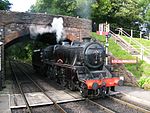 This locomotive was the sole member of the class equipped with Stephenson valve gear. |
| 20 Years, 1 Month | ||||||||||
| 4806 44806 | Derby Works | Domed | Jul 1944 | Aug 1968 | North Yorkshire Moors Railway | Running In [37] | BR Lined Black, Late Crest[38] | No |  Formerly named Magpie and later renamed to Kenneth AldcroftRunning in commenced in December 2023 with full return to service planned for 2024.[38] The engine is to also be mainline certified for use on Grosmont to Whitby & Whitby to Battersby trains.[37] | |
| 24 Years, 1 Month | ||||||||||
| 4871 44871 | Crewe Works | Domed | Mar 1945 | Aug 1968 | East Lancashire Railway | Operational and mainline certified. | BR Lined Black, Early Emblem | Yes | 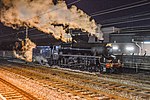 Hauled Fifteen Guinea Special in August 1968.[39] | |
| 23 Years, 5 Months | ||||||||||
| 4901 44901 | Crewe Works | Domed | Oct 1945 | Aug 1965 | Vale of Berkeley Railway | Awaiting restoration from ex-Barry condition | N/A | No |  | |
| 19 Years, 10 Months | ||||||||||
| 4932 44932 | Horwich Works | Domed | Sep 1945 | Aug 1968 | Carnforth MPD | Operational and mainline certified. | BR Lined Black, British Railways Lettering | No |  The engine is to be trialed out with the fitment of ETCS (in-cab signalling).[40] | |
| 22 Years, 11 Months | ||||||||||
| 5000 45000 | Crewe Works | Domeless | Mar 1935 | Oct 1967 | Shildon Locomotion Museum | Static Display. | LMS Lined Black | No |  Part of the National Collection | |
| 32 Years, 8 Months | ||||||||||
| 5025 45025 | Vulcan Foundry | Domeless | Aug 1934 | Aug 1968 | Strathspey Railway | Operational | LMS Lined Black | No |  Oldest surviving member of the class. | |
| 34 Years | ||||||||||
| 5110 45110 | Vulcan Foundry | Domeless | Jul 1935 | Aug 1968 | Carnforth MPD[41] | Stored | BR Lined Black, Late Crest | No |  Purchased from Severn Valley Railway by private owner in August 2023.[42] Hauled Fifteen Guinea Special in August 1968,[39] and formerly named RAF Biggin Hill | |
| 33 Years, 1 Month | ||||||||||
| 5163 45163 | Armstrong Whitworth | Domed | Aug 1935 | May 1965 | Colne Valley Railway | Under restoration. | N/A | No |  | |
| 29 Years, 9 Months | ||||||||||
| 5212 45212 | Armstrong Whitworth | Domed | Nov 1935 | Aug 1968 | Keighley and Worth Valley Railway | Operational and mainline certified. | BR Lined Black, Late Crest | Yes | 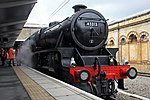 | |
| 32 Years, 9 Months | ||||||||||
| 5231 45231 | The Sherwood Forester | Armstrong Whitworth | Domed | Aug 1936 | Aug 1968 | Crewe Diesel TMD | Operational and mainline certified. | BR Lined Black, Late Crest | Yes |  |
| 32 Years | ||||||||||
| 5293 45293 | Armstrong Whitworth | Domed | Dec 1937 | Aug 1965 | Colne Valley Railway | Under restoration. | N/A | No | 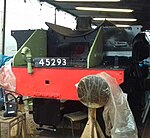 | |
| 27 Years, 8 Months | ||||||||||
| 5305 45305 | Alderman A. E. Draper | Armstrong Whitworth | Domed | Jan 1937 | Aug 1968 | Great Central Railway | Under overhaul | TBC | No |  |
| 31 Years, 7 Months | ||||||||||
| 5337 45337 | Armstrong Whitworth | Domed | Apr 1937 | Feb 1965 | East Lancashire Railway | Under overhaul | LMS Lined Black (on completion)[43] | No | 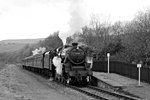 | |
| 27 Years, 10 Months | ||||||||||
| 5379 45379 | Armstrong Whitworth | Domed | Jul 1937 | Jul 1965 | Mid-Hants Railway | Stored | BR Lined Black, Late Crest | No | 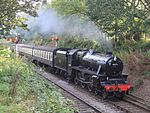 Boiler ticket expired in early September 2018 | |
| 28 Years 1 Month | ||||||||||
| 5407 45407 | The Lancashire Fusilier | Armstrong Whitworth | Domed | Sep 1937 | Aug 1968 | East Lancashire Railway | Operational and Mainline Certified | BR Lined Black, Early Emblem | Yes |  |
| 30 Years, 11 Months | ||||||||||
| 5428 45428 | Eric Treacy | Armstrong Whitworth | Domed | Oct 1937 | Oct 1967 | North Yorkshire Moors Railway | Operational and mainline certified. | LMS Lined Black | No |  |
| 30 Years | ||||||||||
| 5491 45491 | Derby Works | Forward Topfeed | Dec 1943 | Jul 1965 | Great Central Railway | Under restoration | N/A | No | 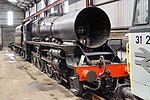 Only surviving example having a boiler with top feed on the front ring in conjunction with Walschaerts valve gear. | |
| 21 Years, 7 Months | ||||||||||
† In all cases names are historically inaccurate, i.e. they have all been applied since preservation. Some engines might still have their names but where marked indicates that they currently do not carry them. Either for authenticity or other reasons like the engine is running in another identity.
- 44767 carries a plaque on the splasher beneath the nameplate that reads 'This locomotive was named by the Rt. Hon. William Whitelaw, C.H., M.C., M.P. at Shildon on 25 August 1975, to commemorate the 150th anniversary of the Stockton and Darlington Railway.'
- 44806 was named after the TV series "Magpie" in 1973, it continued to wear this name during the time it was based at the Lakeside and Haverthwaite Railway and when it relocated to the Llangollen Railway until it was withdrawn for overhaul in 2003. After emerging from its last overhaul in 2007 it ran without the nameplates but was later named after its former owner "Kenneth Aldcroft". It is now based at the North Yorkshire Moors Railway and has since had its nameplates removed.
Sound
In fiction
In The Railway Series children's books by the Rev. W. Awdry and its television adaption Thomas and Friends, the character Henry the Green Engine was rebuilt into a Black Five at Crewe Works after his accident with the Flying Kipper.[45]
In artwork
A Black 5 locomotive appears in the 1938 René Magritte painting Time Transfixed.[46][47]
See also
Further reading
- David Hunt, Bob Essery and Fred James with David Jennison and David Clarke LMS Locomotive Profiles (three volumes, three pictorial supplements):
- No. 5 The mixed traffic class 5s. Part 1. Nos. 5000–5224. (+ pictorial supplement)
- No. 6 The mixed traffic class 5s. Part 2. Walschaerts and Stephenson valve gear engines from the 5225–5499 and 4658–4999 series. (+ pictorial supplement)
- No. 7 Mixed traffic class 5s: Caprotti valve gear engines and class summary (+ pictorial supplement)
- J.S. Whiteley, Gavin Morrison The Power of the Black Fives
References
External links
Bibliography

- Awdry, Wilbert; Awdry, G. (1987). The Island of Sodor: Its People, History and Railways. Kaye & Ward. ISBN 0-434-92762-7.
- Cook, A.F. (1999). Raising Steam on the LMS. Railway Correspondence and Travel Society. ISBN 0-901115-85-1.
- Earnshaw, Alan (1993). Trains in Trouble: Vol. 8. Penryn: Atlantic Books. ISBN 0-906899-52-4.
- Gerard, Malcolm; Hamilton, J. A. B. (1981) [1967]. Trains to Nowhere. London: George Allen & Unwin. ISBN 0-04-385084-7.
- Haresnape, Brian (1970). Stanier Locomotives. Ian Allan. ISBN 0-711010-9-86.
- Hunt, David; James, Fred; Essery, R.J.; Jennison, John; Clarke, David (2004). LMS Locomotive Profiles, no. 6 - The Mixed Traffic Class 5s - Nos. 5225-5499 and 4658-4999. Didcot: Wild Swan. ISBN 1-874103-93-3.
- Jennison, John (2015). A detailed history of The Stanier Class Five 4-6-0s Volume 2 - on 45472-45499, 44658-44999. Locomotives of the LMS. Maidenhead: RCTS. ISBN 978-0-901115-99-7.
- Jennison, John; Clarke, David; Hunt, David; James, Fred; Essery, R.J. (2004). Pictorial Supplement to LMS Locomotive Profile no. 6 - The Mixed Traffic Class 5s - part 2, nos. 5225-5499 and 4658-4999. Didcot: Wild Swan. ISBN 1-874103-98-4.
- Nock, O.S. (1989). Great Locomotives of the LMS. Wellingborough: Patrick Stephens Ltd. ISBN 1-85260-020-9.
- Rowledge, J.W.P. (1975). Engines of the LMS built 1923–51. Oxford: Oxford Publishing Company. ISBN 0-902888-59-5.
- Rowledge, J. W. P.; Reed, Brian (1984) [1977]. The Stanier 4-6-0s of the LMS. Newton Abbot: David & Charles. ISBN 0-7153-7385-4.
- Trevena, Arthur (1980). Trains in Trouble. Vol. 1. Redruth: Atlantic Books. ISBN 0-906899-01-X.
- Trevena, Arthur (1981). Trains in Trouble: Vol. 2. Redruth: Atlantic Books. ISBN 0-906899-03-6.